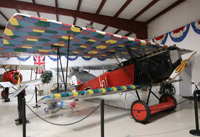|
Fokker |
|
|
D.VII
# |

|
Photo:
Robert Deering 10/18/2012
National Museum of
the USAF
Wright-Paterson AFB (FFO)
Dayton, Ohio |
| |
|
.jpg)
Photo: Robert
Deering 4/18/2015
National Museum of Naval Aviation
NAS
Pensacola (NPA)
Pensacola, Florida |

Photo: Robert
Deering 5/27/2017
Cavanaugh Flight Museum
Addison Airport (ADS)
Addison, Texas |
|
|
First
appearing entering combat in May 1918, the Fokker D.VII
quickly showed its superior performance over Allied
fighters. With its high rate of climb, higher ceiling
and excellent handling characteristics, German pilots
scored a remarkable 565 victories over Allied aircraft
during the month of August alone.
Designed by Reinhold Platz, the prototype of the D. VII
flew in a competition against other new fighter aircraft
in early 1918. After Baron Manfred von Richthofen,
the famous Red Baron, flew the prototype and
enthusiastically recommended it, the D. VII was chosen
for production. To achieve higher production rates,
Fokker, the Albatross company and the Allgemeine
Elektrizitats Gesellschaft (AEG) all built the D. VII.
By war's end in November 1918, these three companies had
built more than 1,700 aircraft.
|
|
SPECIFICATIONS:
|
PERFORMANCE: |
| Span:
29 ft. 3.5 in.
|
Maximum speed:
120 mph (Mercedes engine); 124 mph
(BMW engine)
|
|
Length:
22
ft. 11.5 in. |
Cruising speed:
|
|
Height:
9
ft. 2.5 in. |
Range:
|
|
Empty Weight:
1,540 lbs |
Service ceiling:
18,000 ft. (Mercedes engine);
21,000 ft. (BMW engine) |
|
Gross Weight:
1,939
lbs. loaded
|
|
|
Crew:
Pilot |
|
Engines:
Mercedes 160 hp or BMW 185 hp
|
|
Armament:
Two
7.92 Spandau machine guns |
| |
|
|
SOURCE:
National Museum of the United States Air Force |
|
|